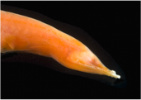In the 2010 State of Observed Species researchers have announced that 18,225 living species were discovered in 2008. In addition, 2,140 new extinct species were discovered byway of fossils.
For researchers the easiest new species to discover were insects: over 48 percent of the new species described in 2008 were insects. Over a third of the new insects were beetles. Mammals were among the most difficult: researchers discovered only 41 new species of mammal in 2008, nearly a third of which were rodents. Five times as many extinct mammals were found as living species.
To date insects represents a majority of the world’s species with just over a million insects described. Plants come in second with just over a quarter-million. As of 2008, researchers have described 9,997 birds, 8,863 reptiles, 6,644 amphibians, and 5,528 mammals. In all, scientists have described almost 2 million species (1,922,710) since taxonomic work began in the 18th Century.
 Unidentified planthopper insect from Madagascar. Scientists estimate that at best 20 percent of the world’s species have been described. Photo by: Rhett A. Butler. |
However, most of the world’s species remain unknown to researchers. According to the report, scientists believe that there are at least 10 million species in the world, as well as tens of millions of microbes. If the current rate of discovery (i.e. approximately 18,000 new species a year) continues, it will take taxonomists 444 more years to describe the world’s estimated remaining 8 million (non-microbial) species.
However, if higher total species estimations prove correct, for example 50 million species, then it would take two and half millennia before the world’s species are described at the present rate.
Whether 8 million or 48 million species remain undiscovered by researchers, many of these species may vanish before scientists find them. Extinction rates are currently estimated at 100 to 1000 times higher than the background extinction rate (i.e. the average extinction rate as determined by studying fossils), leading scientists to warn of a mass extinction that could rival the comet that destroyed the dinosaurs.
To read the report: SOS 2010.
Related articles
Close to a billion species: ocean exploration reveals shocking diversity of tiny marine life

(04/19/2010) Biologists worldwide may have to start re-evaluating their estimates of the number of species on Earth, since expeditions documenting the oceans’ tiniest species have revealed shocking diversity: in the tens of millions of species, at least, and according to one researcher “closer to a billion”. Fourteen field projects sent out by the Census of Marine Life focused on the oceans’ smallest inhabitants: microbes, zooplankton, and tiny burrowing species inhabiting the deep sea bed. What they found was astounding.
Australia starts 10 million dollar initiative to find new species
(02/15/2010) Known as the ‘Bush Blitz’, Australia will spend 10 million Australian dollars (8.88 million US dollars) over the next three years to conduct biodiversity surveys in far-flung places, reports Sydney Morning Herald. The program hopes to both uncover new species and gather more data about innumerable little-known plants and animals on the continent.
Videos and Photos: over 17,000 species discovered in waters beyond the sun’s reach

(11/23/2009) Deep, deep below the ocean’s surface, in a world of ever-present darkness, one would expect few, if any, species would thrive. However, recent expeditions by the Census of Marine Life (CoML) have found an incredible array of strange, diverse, and amazing creatures. To date a total of 17,650 species are now known to live in frigid, nearly lightless waters beyond the photic zone—where enough light occurs for photosynthesis—approximately 200 meters deep. Nearly 6,000 of these occur in even harsher ecosystems, below depths of 1,000 meters or 0.62 miles down.














